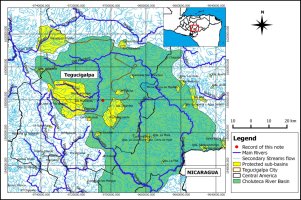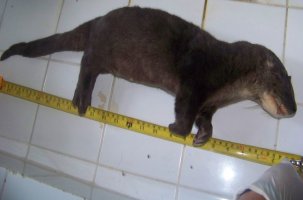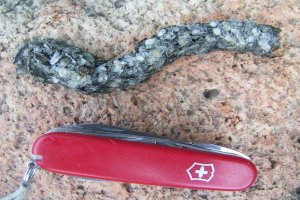IUCN/SSC Otter Specialist Group Bulletin

|
©IUCN/SCC Otter Specialist Group Volume 32 Issue 1 (January 2015) Citation: Aceituno, F, Trochez, D, and Nuñez, C (2015). Recent Record of the Neotropical River Otter (Lontra longicaudis) in the Choluteca River Tegucigalpa, Honduras. IUCN Otter Spec. Group Bull. 32 (1): 25 - 29 Recent Record of the Neotropical River Otter (Lontra longicaudis) in the Choluteca River Tegucigalpa, Honduras Francisco Aceituno1,Delmy Trochez2 and Carmen Nuñez3
1Sub Unidad de Biología y Veterinaria, Zoologico Rosy Walther,
Secretaria de Recursos Naturales, Ambiente y Minas, Tegucigalpa, Honduras
Email: aceitunof@yahoo.com |


 |
| Abstract: We report the presence of the Neotropical river otter (Lontra longicaudis) in the Choluteca River, Tegucigalpa, Honduras. To date the information is the second record verifiable of the species in the Choluteca River since one in the 1940s. |
| Keywords:Lontra longicaudis, Tegucigalpa, Honduras distribution |
| Française | Español |
INTRODUCTION
The Neotropical river otter (Lontra
longicaudis) is a semi-aquatic carnivore, the weight of the species is between 13 -16 kg
average, and mean size 130 -160 cm (Gallo-Reynoso et
al., 2013). The diet is comprised mainly of fish, but also includes
insects, birds, reptiles and fruits (Macias-Sanchez
and Aranda, 1999; Quadros and Monteiro-Filho,
2000; Platt and Rainwater, 2011). The
range of the Neotropical river otter extends from
northwestern of Mexico to
Argentina (Lariviere, 1999). The species has
received relatively little research attention, is classified under
Appendix I of the Convention on International Trade in Endangered
Species of Wild Fauna and Flora (CITES, 2014) and
as “Data Deficient” by the International Union for Conservation of
Nature (IUCN, 2014). In Honduras the species is
thought to be widely distributed, but has been poorly studied and is
listed as a “Species of Special concern” (Vreugdenhil
et al., 2002).
In the Central American region knowledge about the species is generally limited and the studies in the region have focused on occasional records and diet consumption. Spinola and Vaughan (1995) studied the diet of the species at biological station la Selva in Costa Rica: they collected spraints, and analyzed the faeces and reported crustaceans and fish were the most common prey. Rheingantz et al. (2014) estimated the distribution of the neotropical otter river, collecting data from 14 countries for a period from 1991 to 2012. In Central America there is only one record from Costa Rica; beyond that the lack of information shows the importance of research in the region of this species. Herein we report evidence of the Neotropical river otter occurring along the Choluteca River, located in the central region of Honduras.
The Choluteca River (Figure 1) is about 250 km long, draining an area of about 7,848 km2; the drainage includes the capital of Honduras, Tegucigalpa (Reyes, 2001). The river is an important resource for the residents of the city, providing more than 60% of the water for the city (UNAH, 2014). The Choluteca River has experienced significant changes in land use in recent years combining deforestation, conversion to agriculture and human settlement. Deforestation, particularly in the basins, has contributed to sedimentation of river channels and increased potential for flooding on the tributaries; furthermore the proximity to the city has promoted residential, commercial and industrial projects (Procter et al., 2013).
 |
| Figure 1. Location map of Choluteca River and the site of the neotropical otter record (UTM coordinates: 14.046595, -87.181252). (click for larger version) |
On April 1, 2014 a neotropical river otter was killed by children along the Choluteca River in Tegucigalpa city. According the local people the animal was taken from a cave and was beaten to death. The animal was a male, weighed about 2 kg, and total body length (measured from tip of the nose and the tip of the tail) was 65cm (Figure 2); the tail length was the 22 cm. These measurements are consistent in size and weight with a juvenile, according reportsd by Gallo-Reynoso et al., (2013) for the species in Mexico.

|
| Figure 2. Handling of the Neotropical otter for size and weight measurements . (click for larger version) |
A necropsy performed on the carcass showed bleeding associated with lesions to the lung and liver, and hematomas near the right front leg. Tooth replacement was incomplete, the premolars teeth still erupting. The carcass was preserved in 80% ethylic alcohol, and deposited in the mammal collection of the Natural History Museum of National University of Honduras, to provide opportunities for future studies.
The habitat at the site where the Neotropical otter was killed was comprised of riparian vegetation, dominated by a mixture of gallery forest and trees up to 20 m; the predominant species are guarumo (Cecropia sp.), cachito (Mimosa sp.), paraguita (Cyperus sp.), tuna (Opuntia sp.) and guancaste (Enterolobium sp.). The area is at an altitude of 1000 m and is heavily used by local residents for purposes including water supply (Figure 3), extraction of sand from the river, and the banks are used for activities such as roads for livestock and laundry by local communities. Despite human influence, riparian vegetation structure is still present, and the river contains rocks located adjacent to its banks.

|
| Figure 3. Extraction by local people for water supply (click for larger version) |
On June 12, 2014 we conducted field surveys to locate tracks, scats at latrines, and dens to determine if a population of Neotropical river otters was well established in the area where the carcass was collected. We also conducted interviews of residents to determine if they could provide evidence of the species occupying the area. During surveys we located 37 scats among five latrines, which were found on rocks jutting out of the river, over a total of 130m of the same stretch of the river. The spraints were distanced between 15 m - 20 m. The largest number of scats found at one place was seven and the lowest was three; the size of scats averaged 8 cm (Figure 4). The scats were mostly dry and were identified according to the description provided by Aranda (2000), with most being composed of bones and fish scales. No dens were located; however, on the banks of the river there are tree roots that have cavities that could be used as dens: Pardini and Trajano (1999) found that caves under tree roots were one of the most used shelters by Lontra longuicaudis in southern Brazil.
Previous to this specimen being found, Goodwin (1942), reports a specimen that had been shot and was found in the Choluteca River. Our report demonstrates that a population of Neotropical river otters still exists along the river, and this is only the second report of the species from this river drainage. The occurrence of a population of the species in the portion of river described in our report is particularly interesting given that the area is highly disturbed by human activity, suggesting that the Neotropical may be tolerant of presence of humans and associated activities. Studies of the Neotropical river otter are needed in Honduras to better understand the species’ distribution and to serve as a basis for better developing and conservation practices.
Acknowledgements - We are very grateful to Eriberto Godoy and Antonio Cortez who delivered the specimen. We also thank Dr. Diana Echeverria for carrying out the necropsy and Raquel Vargas who prepared the translation for submission of the manuscript. Thanks to Julio Merida and Gustavo Cruz of the Natural History Museum of National University of Honduras Museum: they made useful comments on the manuscript. We also thank the reviewers that helped to improve the manuscript.
REFERENCES
Aranda, M. (2000). Huellas y otros rastros de los mamíferos grandes y medianos de México, Comisión Nacional para el Conocimiento y Uso de la Biodiversidad, Instituto de Ecología, A. C. Xalapa, Veracruz, México, 212 pp.
CITES (2014). Convención sobre el Comercio Internacional de Especies Amenazadas de Fauna y Flora Silvestres. 2013. Apéndice I, II y III, en vigor a partir del 14 de septiembre de 2014.
Gallo-Reynoso, J.P., Samuel M.C., Edith, A.N., Alberto, G. (2013). Longitud, masa corporal, y crecimiento de la nutria neotropical (Lontra longicaudis annectens) en México. Therya 4(2): 219-230.
Goodwin, G.G. (1942). Mammals of Honduras. Bulletin American Museum of Natural History. LXXIX: 107-195.
IUCN. (2014). Red List of Threatened Species. International Union for the Conservation of Nature. Available from: www.iucnredlist.org. [Downloaded on 21 July 2014.]
Lariviere, S. (1999). "Lontra longicaudis". Mammalian Species 609:1-5.
Macías-Sánchez, S., Aranda, M. (1999). Análisis de la alimentación de la nutria Lontra longicaudis (Mammalia: carnívora) en un sector del rio de los pescados, Veracruz, Mexico. Acta Zoologica Mexicana. 76: 49-57.
Pardini, R., Trajano, E. (1999). Use of shelters by the neotropical river otter (Lontra longicaudis) in atlantic forest stream, southeastern Brazil. Journal of Mammalogy 80(2):600-610.
Platt, S.G., Rainwater, T.R. (2011). Predation by neotropical otters (Lontra longicaudis) on turtles in Belize. IUCN Otter Spec. Group Bull. 28: 4-10.
Procter A., Díaz Briones A., Vignola R., McDaniels T. (2013). Using Forests to Enhance Resilience to Climate Change: Case Study of the role of forests in contributing to adaptation of drinking water system in Tegucigalpa Honduras. Bogor Indonesia: Centre for International Forestry Research.108 pp.
Quadros, J., Monteiro-Filho, E.L.A. (2000). Fruit occurrence in the diet of neotropical otter, Lontra longicaudis in southern brazilian Atlantic forest and its implication for seed dispersion. Journal Neotropical Mammalogy, 7(1): 33-36.
Reyes, L.P. (2001). Problemática de la calidad del agua en la Cuidad de Tegucigalpa. Congreso de Centroamérica y Panamá de Ingeniería sanitaria y ambiental. Tegucigalpa, 46pp.
Rheingantz, M.L., Saravia de Menezes, J.F., de Thoisy, B. (2014). Defining Neotropical otter Lontra longicaudis distribution, conservation priorities and ecological frontiers. Tropical Conservation Science 7 (2): 214-229.
Spínola, R.M., Vaughan, C. (1995). Dieta de la nutria neotropical (Lutra longicaudis) en la Estación Biológica la Selva, Costa Rica. Vida Silvest. Neotrop. 4: 125-132.
UNAH (2014). Estudio Hidrogeoquímico de la parte alta de la cuenca del Rio Choluteca. Universidad Nacional Autónoma de Honduras (UNAH), Tegucigalpa, 159 pp.
Vreugdenhil D.X., House, P.R., Cerrato, C.A., Martínez, R.A., Pereira, A.C. (2002). Racionalización del Sistema Nacional de las Áreas Protegidas de Honduras. Volumen I: Estudio Principal. PROBAP/Banco Mundial/UNDP/GEF/WICE.
Résumé : Enregistrement Récent de la Loutre Neotropicale (Lontra longicaudis) dans la Rivière Choluteca à Tegucigalpa au Honduras.
Nous rapportons ici la présence de Loutre du type néotropical (Lontra longicaudis) dans la rivière Choluteca (Tegucigalpa, Honduras). Jusqu'à ce jour, ce rapport constitue la seconde véritable preuve de la présence de cette espèce dans la rivière Choluteca depuis la première observation en 1940.
Revenez au dessus
Resumen: Record Reciente del Nutria Neotropical (Lontra longicaudis) en el Rio Choluteca, Tegucigalpa, Honduras.
Reportamos la presencia de la Nutria Neotropical (Lontra longicaudis) en el Rio Choluteca, Tegucigalpa, Honduras. Hasta la fecha, es el segundo registro verificable de la especie en el Rio Choluteca desde el ultimo realizado en la década de los 40.
Vuelva a la tapa
